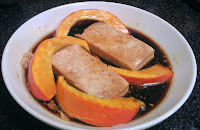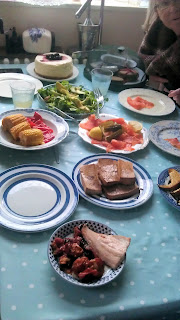The Secret Garden Club returned on November 20 with a session on techniques for smoking food. Taking in tea-smoking, hot-smoking and cold-smoking, Zia Mays explained the principles of each method, using a wide variety of ingredients, while MsMarmiteLover turned the smoked foods into a delicious smoky-themed tea for everyone.
Guests were welcomed with a vodka and smoked lemonade cocktail, before the fires were lit in earnest and smoke wafted into the air.
Smoking techniques
Tea-smoking is a method of hot-smoking, ie, the food is cooked at the same time as being smoked. It uses a mix of tea leaves, brown sugar, raw rice and optional aromatics as the smoking medium. With the mix set in a pan under a steamer, the smoke generated infuses foods in the steamer basket with a delicate, elusive tea-smoke flavour.
Secret Garden Club tea-smoking mix:
Half a (US) cup of Lapsang Souchong tea leaves (about 30g)
Half a (US) cup of brown sugar (about 75g)
Half a (US) cup of raw long-grain rice (about 75g)
This was used to smoke:
Trout fillets – marinaded for one hour beforehand in whisky;
Tomatoes – cut in half hemispherically and lightly roasted in the oven for 20 minutes before smoking.
Also good with chicken – use thin fillets to ensure they are cooked through, duck, quail. With tea-smoking, less is definitely more: over-smoke the food and you’ll be left with a distinct aftertaste of fag packet.
Hot-smoking over wood applies direct heat to soaked woodchips so that they smoulder gently. The wood and the food are both in a sealed unit so that the heat and smoke permeate the food to cook and smoke it at the same time.
Important: when smoking food with any kind of wood, it is vitally important that the wood is raw, and untreated. Any sort of treatment, coating, glue or varnish will give off potentially toxic fumes when smoked – NOT what you want coating your food. If the wood you want to use has been cut with a chainsaw, beware – there could easily be oil residues on the wood from the chainsaw. It’s highly satisfying to use wood that you have chopped or sourced yourself, but you must be 100% certain that the wood is free of any chemicals.
We smoked vegetables in the hot-smoker:
- Sweet peppers;
- Pumpkins, cut into thin wedges and marinaded for two hours beforehand in a mix of soy sauce and maple syrup;
- Chillies;
- Tofu, cut into thick slices and marinaded for two hours beforehand.
- Sweetcorn, on the cob;
- Apples, following a baked apple recipe but with added smokiness.
 Basic marinade for the tofu, pumpkins:
Basic marinade for the tofu, pumpkins:
3 tbsp soy sauce
3 tbsp maple syrup
A dash of sesame oil
A dash of olive oil
Half a teasp of English mustard powder
The sweetcorn and baked apples were particularly successful. We’ve had variable results with tofu: firstly, try to get firm tofu so that it doesn’t disintegrate when you try to handle it. Tofu definitely needs to be marinaded first for a good two hours – and a more Japanese style marinade with mirin and wasabi would also work well here.
Cold-smoking is the technique we associate most with fish – think smoked salmon, smoked mackerel, smoked haddock – and meat – smoked bacon. However, it’s also used to smoke cheese (such as applewood-smoked cheddar) and bulbs of garlic. When you expose food to cold, or cool, smoke, the food does not cook, although the smoke will penetrate the food more thoroughly than when hot-smoked.
With tin, soldering iron and food positioned this way, the smoke around the food should stay cool enough to cold smoke properly. We recommend you place a thermometer on the rack next to the food and check the temperature regularly. On a sunny day, the outside temperature may make the barbecue heat up – and it’s not something to do in midsummer. Cold smoking this way is a wintertime occupation. If you do see the temperature rising much above 30 degrees, slide a bag of ice into the bottom of the barbecue. This should bring the temperature down to the safe range and keep it there.






Leave a Reply